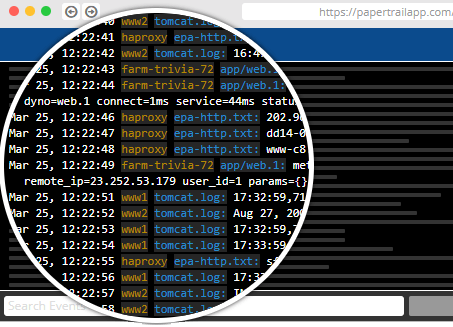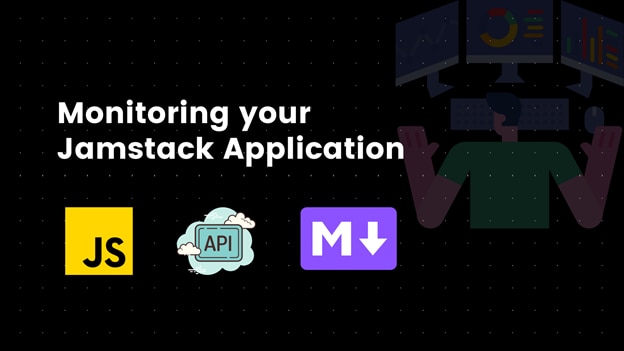Tips from the Team
By engineers, for engineers
At SolarWinds Papertrail we are software engineers who are passionate about programming, debugging, logging and pretty much everything about building and running applications. We enjoy keeping our coding skills sharp and playing with new technologies. Below are some of things we have picked up along the way.
Fully Functional for 30 Days

How to Diagnose App Issues Using Crash Logs
Best Practices for Centralized Logging in Microservices Architecture
Logging With NGINX – How to Configure It and What to Watch Out For
Cloud-Based, Cloud-Native, and Cloud-Enabled Applications—What’s the Difference?
How to Live Tail Docker Logs
7 Best Practices for C# Logging (With Examples)
Export Apache Kafka Logs to Papertrail: A How-to Guide
Monitoring JAM Stack (JavaScript, API, and Markup)
Cloud-Native Applications and Log Management Best Practices
What Are Containers and Containerization in DevOps?
How to Diagnose App Issues Using Crash Logs
Last updated: October 2025
Mobile app crashes can be a real headache in the world of software development. They not only lead to user frustration and productivity loss but also tarnish your organization’s reputation. As a mobile developer, one of the most valuable tools in your troubleshooting arsenal is the crash log.
When mobile apps crash, they generate logs that contain information related to the issues that caused the crash. Examining the log is a good starting point for diagnosing and resolving the crash.
Best Practices for Centralized Logging in Microservices Architecture
Last updated: December 18, 2023
Microservice architectures bring significant benefits to software teams. Microservices allow a team to scale individual parts of their application independently. They provide huge benefits in resilience, too. An application with a memory leak in a troublesome spot is a big problem for a monolithic architecture. One bug takes down the whole system and leads to extended outages. With a microservice architecture, a memory leak only takes down one part of the swarm. However, there are downsides to the microservice approach. For starters, microservices complicate deployment plans. While you can solve some of those complications with orchestration tools, it’s another layer of technology in your stack.
Logging With NGINX – How to Configure It and What to Watch Out For
Last updated: October 2025
As web applications become more complex, a need for monitoring and observation emerges. Configuring NGINX logs can be challenging; misconfigured logs can result in the loss of critical data or excessive storage usage. Additionally, incorrect configuration may expose your server to security vulnerabilities.
This post is a comprehensive guide on logging with NGINX. We’ll examine the configuration of NGINX logs and potential aspects to watch out for, ensuring you can fully leverage the potential of NGINX logs while maintaining the security of your web server.
Cloud-Based, Cloud-Native, and Cloud-Enabled Applications—What’s the Difference?
Last updated: October 10, 2025
There are numerous “cloudy” terms out there now. Is cloud-native better than cloud-based? Am I in the “cloud” when I enable my application for the cloud? Is there even any difference between these terms?
“Cloud-native”, “cloud-based”, and “cloud-enabled” are three different approaches to leveraging cloud computing in the world of software development and deployment. In this post, we’ll take a closer look at these approaches, shedding light on their specifics and how they’re different.
How to Live Tail Docker Logs
Last updated: October 9, 2025
Docker has improved how we develop, package, and deploy applications. It allows us to encapsulate logic and
dependencies in a container ready to run on any platform. However, each container produces individual logs, which
are challenging to manage and correlate. Logs record events that occur in a system and are very useful for
debugging. Consequently, we require a method to access the container logs. docker logs --tail
is a
command that allows us to follow specific log outputs of our container.
7 Best Practices for C# Logging (With Examples)
Last updated: October 14, 2025
In the world of software development, logging often takes a backseat to unit testing and documentation. However, logging is a critical tool for debugging in production, providing insights into the real-world use of your application. When things stop working, it’s the data in the logs that both the development and operations teams use to troubleshoot the issue and quickly fix the problem.
Export Apache Kafka Logs to Papertrail: A How-to Guide
Kafka is an open-source publish/subscribe platform. It can act as a message broker and as a fault-tolerant storage system. Its speed and reliability make it a natural choice for managing communications between enterprise applications, so being able to monitor your Kafka systems is critical.
In this tutorial, we’ll see how easy it is to connect your Kafka logs to Papertrail™ so you can take advantage of its ability to store, index, and instrument your messaging logs.
Monitoring JAM Stack (JavaScript, API, and Markup)

Jamstack came out just six years ago but has gained traction rapidly among the community. In fact, Netlify’s 2020 State of the Jamstack Survey states more than two-thirds of respondents have been using it for the last two years.
Cloud-Native Applications and Log Management Best Practices
Why Are Cloud-Native Applications Necessary?
The traditional application development paradigm involves practices and tools for developing applications. This paradigm builds upon monolithic architecture, which is centered around the idea of “interconnectedness” and “dependency.”
What do I mean by “interconnectedness” and “dependency”? The former refers to applications developed so each component interconnects with the other components. Thus, lines of code and functions within one component are intertwined with the others. What happens when one of the components fails to function? Due to the interconnected, monolithic architecture, the entire application fails due to its dependence on this failed component.
What Are Containers and Containerization in DevOps?
Nowadays, most software is built using a microservices architecture. The easiest way to build microservices is by using containers. But technology and architecture are only half of the equation.
Processes, company culture, and methodologies also play a significant role in the software development process. For this part, the most popular approach is to follow DevOps practices. Containers and DevOps complement each other. In this post, you’ll learn how one relates to the other, and what containerization and DevOps are all about.